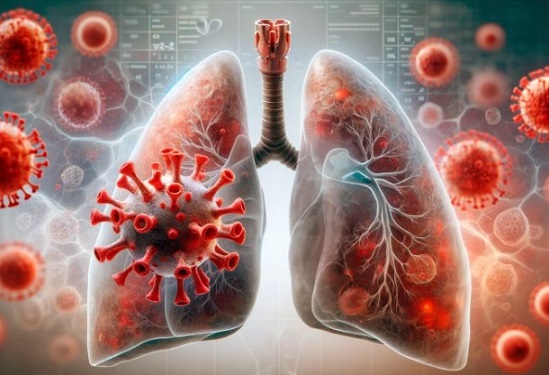SARS-CoV-2 Clogs Lung Cells, Disrupting Air Exchange and Causes Multi-Organ Damage
Nikhil Prasad Fact checked by:Thailand Medical News Team Apr 08, 2025 4 days, 19 hours, 27 minutes ago
Medical News: Researchers from Sharda University in India have made a critical discovery in understanding how the SARS-CoV-2 virus - responsible for COVID-19, disrupts oxygen exchange in the lungs, leading to severe respiratory distress and potentially fatal outcomes. The study provides detailed insights into the cellular-level damage inflicted by the virus, especially on specialized lung cells known as alveolar type-2 cells, which are vital for breathing and oxygen absorption into the bloodstream.
 SARS-CoV-2 Clogs Lung Cells, Disrupting Air Exchange and Causes Multi-Organ Damage
SARS-CoV-2 Clogs Lung Cells, Disrupting Air Exchange and Causes Multi-Organ Damage
The researchers conducted in-vitro experiments using various human lung and vascular cell lines, including Alveolar Epithelial Cells (A549 and L-132), Human Pulmonary Artery Endothelial Cells (HPAEC-c), and Fibroblasts (WI-38). These were infected with live SARS-CoV-2 to observe the viral lifecycle and its impact on the lung tissue’s cellular architecture. This
Medical News report reveals for the first time how the virus exploits host cell machinery in an entirely unique and highly destructive manner.
Viral Overload in Lung Cells Creates Vacuoles That Block Oxygen Transfer
One of the most alarming discoveries was the formation of numerous large vacuoles - essentially bubble-like structures - inside the alveolar type-2 cells after infection. These vacuoles were observed to be completely filled with newly formed SARS-CoV-2 virions. Normally, these lung cells help mix inhaled air with pulmonary surfactant and allow oxygen to diffuse into blood vessels while taking in carbon dioxide for expulsion. However, with the vacuoles occupied by virus particles, the cytoplasmic space becomes heavily congested. This clogs the cells’ internal transport pathways and prevents proper movement of oxygen, drastically impairing gas exchange.
As a result, the lungs become unable to deliver sufficient oxygen into the bloodstream. This blockage in the cellular architecture is likely a major contributor to the respiratory distress, hypoxia, and multi-organ damage seen in severe COVID-19 patients.
Unique Exit Strategy of the Virus May Explain Multi Organ Involvement
In addition to congestion inside lung cells, the study also discovered a never-before-seen bypass mechanism that SARS-CoV-2 uses to exit infected cells. Unlike most viruses that rely on typical endocytic and exocytic pathways, SARS-CoV-2 hijacks an alternative route by fusing large virus-laden vacuoles with lysosomes. This fusion enables the viral cargo to be released directly into the extracellular matrix. From there, the virus can spread to neighboring cells and tissues without relying on blood flow or immune evasion tactics.
This unusual egress strategy potentially allows the virus to travel from the lungs to other organs more easily, contributing to the wide systemic effects seen in severe or long COVID cases, such as cardiac issues, kidney failure, and brain inflammation.
Loss of Cellular Structures and Fragmentation of Mitochondria
t;
The researchers also documented the disintegration of critical internal cellular structures. Mitochondria - the cell’s energy factories - were seen to fragment under the stress of infection, reducing the cell’s ability to sustain normal function. Moreover, the endothelial cells lining the pulmonary arteries showed a significant loss of the glycocalyx layer. This protective sugar-rich lining is essential for maintaining vascular integrity and regulating oxygen and nutrient flow. Its degradation may further compound hypoxia and vascular leakage in COVID-19 patients.
Potential Use of Nitroglycerine Based Drugs to Restore Lung Cell Function
Interestingly, the team also proposed a potential therapeutic avenue to counteract the cellular damage. Since the cytoplasmic viscosity inside infected cells becomes disrupted due to viral vacuolization, the researchers suggest that repurposed nitroglycerine-based drugs might help restore optimal internal conditions within alveolar type-2 cells. This could theoretically improve oxygen movement and alleviate respiratory symptoms, although further clinical studies are required.
Conclusion
This new study provides significant insight into the actual intracellular events that lead to the gas exchange failures in the lungs of COVID-19 patients. The formation of vacuoles stuffed with virus particles within alveolar cells emerges as a key mechanical obstruction to oxygen diffusion. The observed bypass exit pathway used by the virus to evade traditional cellular trafficking and spread to multiple organs is another alarming feature that may explain the wide range of COVID-related complications. Most importantly, this study emphasizes that it is not just inflammation or immune overreaction that kills, but a systematic viral hijacking of essential respiratory cell function that leads to hypoxia and multi-organ failure.
These findings open the door to developing targeted therapies that restore intracellular conditions and block viral trafficking routes. Future clinical research may soon offer interventions capable of reversing the cellular damage and restoring lung performance in affected individuals.
The study findings were published in the peer reviewed journal: Heliyon
https://www.sciencedirect.com/science/article/abs/pii/S0040816625001764
For the latest COVID-19 News, keep on logging to Thailand
Medical News.
Read Also:
https://www.thailandmedical.news/news/sars-cov-2-uses-heme-and-complement-factor-h-for-immune-evasion
https://www.thailandmedical.news/news/researchers-from-mexico-find-that-calcium-dobesilate-helps-in-treating-covid-19
https://www.thailandmedical.news/news/swedish-study-alarmingly-finds-that-covid-infections-increases-the-risk-of-developing-demyelinating-diseases
https://www.thailandmedical.news/articles/coronavirus
https://www.thailandmedical.news/pages/thailand_hospital_listings
https://www.thailandmedical.news/pages/thailand_doctors_listings
